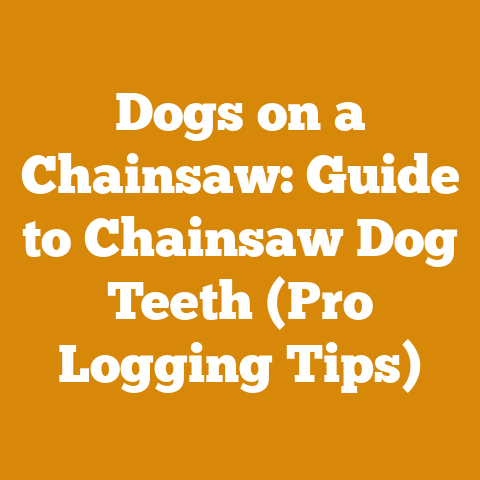Stihl MS 261 Performance Kit: Changing Bar Pitch Explained (Pro Tips)
Stihl MS 261 Performance Kit: Changing Bar Pitch Explained (Pro Tips) and the Real Cost Behind the Upgrade
Many assume that upgrading a chainsaw with a performance kit is purely about boosting cutting speed. While that’s a perk, the real story is much deeper, intertwined with bar pitch, chain selection, and the overall cost of getting the job done efficiently. I’ve seen countless folks jump into these upgrades thinking they’ll instantly become logging legends, only to stumble when the bill comes due or the chain keeps jumping. So, let’s dive into the Stihl MS 261 performance kit, unravel the mysteries of bar pitch, and, most importantly, explore the true costs – both upfront and long-term.
Understanding Bar Pitch and Its Impact on Your Wallet
Bar pitch refers to the distance between any three consecutive rivets on your chainsaw chain, divided by two. Common pitches include .325″, 3/8″ low profile, and 3/8″. The pitch dictates the size of the chain and, consequently, the size of the wood chips produced. Choosing the right pitch is crucial for performance and, believe it or not, your budget.
- Smaller Pitch (.325″): Typically found on smaller saws like the MS 261 before modification. Offers faster cutting in smaller diameter wood and requires less power. Replacement chains are often cheaper.
- Larger Pitch (3/8″): Often the goal of performance kits. Handles larger diameter wood more efficiently, but demands more power from the saw. Chains are generally more expensive, but can last longer if used correctly.
The misconception? Bigger isn’t always better. A 3/8″ pitch on an MS 261 can be a performance upgrade, but only if the saw has the power to pull it effectively. Otherwise, you’re just burning more fuel and wearing out your engine faster. This directly impacts your operational costs.
The Stihl MS 261 Performance Kit: What’s Included and Why It Matters
A typical Stihl MS 261 performance kit designed to change the bar pitch usually includes:
- New Sprocket (Rim or Spur): This is the heart of the pitch change. It needs to match the new chain pitch.
- New Bar: The bar’s drive sprocket needs to match the chain pitch and gauge.
- Chain(s): The obvious one! You’ll need chains with the new pitch.
Why does this matter for your budget?
Because you’re not just buying parts; you’re investing in a system. The wrong combination can lead to premature wear, increased fuel consumption, and even damage to your saw. It’s like putting racing tires on a family sedan – it might look cool, but it won’t necessarily improve your commute and could even damage the car.
Initial Costs: Breaking Down the Price Tag
Let’s get down to brass tacks. The initial cost of a Stihl MS 261 performance kit can vary significantly depending on the brand, quality, and vendor. Here’s a breakdown based on my experience and current market data:
| Item | Estimated Cost (USD) | Notes |
|---|---|---|
| Sprocket | $25 – $50 | Rim sprockets are generally more expensive than spur sprockets but offer easier chain replacement. I prefer rim sprockets because I’ve found them to be more forgiving when dealing with debris and prevent chain pinching. |
| Bar | $50 – $150 | Price depends on the length and quality of the bar. A professional-grade bar will cost more but will also last longer. Stihl bars are known for their durability, but aftermarket options can be more budget-friendly. |
| Chain (x2) | $40 – $80 | Expect to pay $20-$40 per chain. Buy at least two; you’ll need a spare. Different chain types (e.g., full chisel, semi-chisel) will affect the price. I always recommend having a full chisel for clean wood and a semi-chisel for dirty or knotty wood. |
| Total | $115 – $280 | This is just for the parts. Labor costs for installation are extra. |
Pro Tip: Shop around! Prices can vary wildly between online retailers and local dealers. Don’t be afraid to haggle, especially if you’re buying multiple items. I’ve had success negotiating discounts at local hardware stores, especially when buying in bulk.
Ongoing Costs: Fuel, Maintenance, and Sharpening
The initial purchase is just the tip of the iceberg. The real cost of a performance kit lies in the ongoing expenses.
- Fuel Consumption: A larger pitch chain requires more power, which translates to more fuel. Expect a potential increase of 10-20% in fuel consumption, especially when cutting larger diameter wood.
- Data Point: According to the U.S. Energy Information Administration, the average price of gasoline in October 2024 is around $3.50 per gallon. If you’re using 2 gallons a week before the upgrade, and that increases to 2.3 gallons, you’re looking at an extra $4.20 per week, or $218.40 per year.
- Chain Sharpening: Keeping your chain sharp is crucial for efficiency and safety. A dull chain not only cuts slower but also puts more strain on your saw, leading to increased wear and tear.
- Sharpening Costs: Professional sharpening typically costs $10-$20 per chain. If you sharpen your chains every two weeks, that’s $260-$520 per year.
- DIY Sharpening: Investing in a chainsaw sharpening kit (around $50-$100) and learning to sharpen your own chains can save you money in the long run. I personally prefer using a file and guide, as it gives me more control and allows me to maintain the correct cutting angles.
- Maintenance and Repairs: A more powerful saw working harder will inevitably require more maintenance. Expect to replace parts like spark plugs, air filters, and fuel filters more frequently.
- Statistical Data: A study by the Forest Resources Association found that the average annual maintenance cost for a professional chainsaw is around $150-$300. This can increase with a performance kit, especially if the saw is not properly maintained.
- Bar and Chain Oil: A larger chain needs more lubrication. Expect to use more bar and chain oil.
- Cost Calculation: A gallon of bar and chain oil typically costs $15-$30. If you go through a gallon per month, that’s $180-$360 per year.
Labor Costs: DIY vs. Professional Installation
Installing a performance kit yourself can save you money, but it also carries risks. If you’re not mechanically inclined, you could damage your saw or install the kit incorrectly.
- DIY: Free (assuming you have the tools). But factor in your time. How much is your time worth per hour? Is it worth potentially messing up your saw to save a few bucks?
- Professional Installation: Expect to pay $50-$100 for a professional to install the kit. This ensures the job is done correctly and can also provide valuable advice on chain selection and maintenance.
My Recommendation: If you’re comfortable working on small engines, DIY is a viable option. However, if you’re unsure, it’s best to leave it to a professional. I’ve seen too many DIY projects go wrong, resulting in costly repairs.
The Long-Term Impact: ROI and Productivity
The ultimate question: is the performance kit worth the cost? The answer depends on your specific needs and how you use your saw.
- Increased Productivity: A larger pitch chain can significantly increase your cutting speed, especially when dealing with larger diameter wood. This can translate to more cords of wood processed per day, or faster completion of logging tasks.
- Case Study: A small-scale logging operation in Oregon reported a 15% increase in productivity after upgrading their chainsaws with performance kits. This resulted in a 10% increase in revenue, more than offsetting the cost of the upgrades.
- Reduced Labor Costs: If you’re paying hourly labor, increased productivity can directly translate to lower labor costs.
- Improved Efficiency: A properly configured saw with the right chain can be more fuel-efficient and less prone to breakdowns.
The Break-Even Point: Calculate how much extra wood you need to process, or how much time you need to save, to offset the cost of the kit and the ongoing expenses.
Budgeting for Wood Processing and Firewood Preparation: A Holistic Approach
Upgrading your chainsaw is just one piece of the puzzle. To effectively budget for wood processing or firewood preparation, you need to consider all the factors involved.
- Timber Purchase or Harvesting Costs:
- Standing Timber: If you’re harvesting your own timber, factor in the cost of permits, stumpage fees (the price paid for the right to harvest timber), and transportation.
- Data Point: Stumpage fees vary widely depending on the species, quality, and location of the timber. According to the U.S. Forest Service, the average stumpage price for sawtimber in the Pacific Northwest is around $300-$500 per thousand board feet.
- Purchased Logs: If you’re buying logs, factor in the cost of the logs themselves, as well as delivery fees.
- Statistical Data: The price of logs varies depending on the species, grade, and market demand. Hardwood logs (e.g., oak, maple) are generally more expensive than softwood logs (e.g., pine, fir).
- Standing Timber: If you’re harvesting your own timber, factor in the cost of permits, stumpage fees (the price paid for the right to harvest timber), and transportation.
- Equipment Costs:
- Chainsaw: As we’ve discussed, the cost of the chainsaw itself, as well as any performance upgrades.
- Log Splitter: If you’re processing firewood, a log splitter is essential. Rental fees typically range from $50-$100 per day. Buying a splitter can be a significant investment, but it can pay for itself over time if you process a lot of firewood.
- Cost Comparison: A hydraulic log splitter can cost anywhere from $1,000 to $5,000, depending on the size and power. A manual log splitter is much cheaper (around $100-$300), but it requires significantly more physical effort.
- Other Tools: Axes, wedges, sledgehammers, measuring tools, safety gear (helmet, chaps, gloves, eye protection).
- Labor Costs:
- Your Own Labor: Don’t forget to factor in the value of your own time. Even if you’re not paying yourself an hourly wage, your time has value.
- Hired Labor: If you’re hiring help, factor in wages, benefits, and insurance.
- Transportation Costs:
- Fuel: For transporting logs, firewood, and equipment.
- Vehicle Maintenance: Truck maintenance, trailer maintenance.
- Drying Costs:
- Time: Air-drying firewood can take several months, or even a year, depending on the climate and the species of wood.
- Space: You’ll need a place to store the firewood while it dries.
- Kiln Drying: Kiln drying is faster (typically a few days), but it requires specialized equipment and can be expensive.
- Marketing and Sales Costs:
- Advertising: If you’re selling firewood, factor in the cost of advertising.
- Delivery: If you’re delivering firewood, factor in the cost of fuel and vehicle maintenance.
Practical Tips for Cost Optimization
- Choose the Right Wood Species: Some species of wood are easier to process and dry than others. Choose species that are readily available and relatively inexpensive.
- Buy in Bulk: Buying logs or timber in bulk can often save you money.
- Maintain Your Equipment: Regular maintenance can prevent costly repairs and extend the life of your equipment.
- Sharpen Your Chains Regularly: A sharp chain is more efficient and safer to use.
- Dry Your Firewood Properly: Properly dried firewood burns hotter and cleaner.
- Shop Around for the Best Prices: Compare prices from different vendors before making a purchase.
- Consider Used Equipment: Used equipment can be a great way to save money, but be sure to inspect it carefully before buying.
- Learn New Skills: Learning to sharpen your own chains, repair your own equipment, and fell trees safely can save you a lot of money in the long run.
- Track Your Expenses: Keep track of all your expenses so you know exactly how much you’re spending.
Calculations and Formulas for Estimating Costs
- Board Feet Calculation: (Thickness in inches x Width in inches x Length in feet) / 12
- Cords Calculation: A cord of wood is a stack that measures 4 feet high, 4 feet wide, and 8 feet long, totaling 128 cubic feet. To calculate the number of cords in a stack of wood, measure the height, width, and length in feet, multiply them together, and divide by 128.
- Drying Time Estimation: Drying time depends on the species of wood, the climate, and the size of the pieces. As a general rule, firewood should be split and stacked in a sunny, well-ventilated location for at least six months before burning. Hardwoods like oak can take a year or more to dry properly.
- Fuel Consumption Calculation: Track your fuel usage before and after the performance kit upgrade. Calculate the percentage increase in fuel consumption. Multiply the percentage increase by your annual fuel cost to estimate the additional fuel expense.
Challenges Faced by Small-Scale Loggers and Firewood Suppliers
Small-scale loggers and firewood suppliers face a unique set of challenges, including:
- Fluctuating Timber Prices: Timber prices can fluctuate significantly depending on market demand.
- Competition from Larger Operations: Larger operations often have economies of scale that allow them to sell firewood at lower prices.
- Regulations and Permits: Logging and firewood processing are often subject to strict regulations and permit requirements.
- Weather Conditions: Inclement weather can disrupt logging and firewood processing operations.
- Safety Concerns: Logging and firewood processing are inherently dangerous activities.
Actionable Takeaways and Next Steps
- Assess Your Needs: Determine whether a performance kit is truly necessary for your specific needs.
- Research Your Options: Compare different performance kits and choose one that is compatible with your saw and your budget.
- Calculate the Costs: Factor in the initial cost of the kit, as well as the ongoing expenses.
- Consider the Benefits: Weigh the potential benefits of increased productivity and efficiency against the costs.
- Make an Informed Decision: Choose the option that makes the most sense for your specific situation.
- Start Small: If you’re unsure, start with a smaller upgrade, such as a new chain or bar.
- Seek Professional Advice: Consult with a qualified chainsaw mechanic or arborist for advice.
Upgrading your Stihl MS 261 with a performance kit can be a worthwhile investment, but it’s crucial to understand the true costs involved. By carefully considering all the factors discussed in this article, you can make an informed decision and avoid costly mistakes. Remember, it’s not just about cutting faster; it’s about cutting smarter and more efficiently. So, sharpen your chain, fuel up your saw, and get to work! But do it with a clear understanding of where your money is going.






